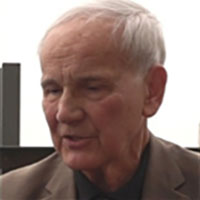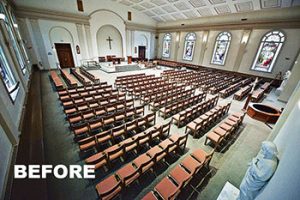 (Collegeville, Liturgical Press, 2019) 236 pages.
(Collegeville, Liturgical Press, 2019) 236 pages.
Richard Vosko was in Australia in February 2019 as keynote speaker at the National Liturgical Architecture and Art Council’s symposium Where Your Treasure Is, There Will Your Heart Be Also: Catholic Liturgical Heritage. Those who met him there will be keen to read this development of his input. Those who did not meet him have the opportunity to make his acquaintance through this book.
The first half of the book sets the context. Vosko begins by describing the polarisation in society and the Church on issues from migration to same-sex unions and he asks, ‘How do we get to a new place?’. He discusses the idea of the common good and proposes that a church building designed to bring people together as equals would affirm such an idea. This type of ‘democratic’ space however risks the criticism that it no longer enshrines a sense of the sacred before a transcendent God. He will argue for the revelation of an immanent God, but not before he examines the assumptions of a traditional cosmology and the nature of hierarchical relationships.
 Vosko spends some time on architectural style, reconciling tradition and innovation by focussing on archetypal elements such as proportion, scale, verticality, harmony, lintels, pathways, focal points, circular motifs, and light (p. 74). He sets memory and imagination alongside tradition and innovation. The first half concludes with an outline of the development of sacramental theology and the liturgy over recent decades. The Church and the Eucharist are to be the sacrament of unity: how can sacred spaces and ritual making bring about such transformation in the community?
Vosko spends some time on architectural style, reconciling tradition and innovation by focussing on archetypal elements such as proportion, scale, verticality, harmony, lintels, pathways, focal points, circular motifs, and light (p. 74). He sets memory and imagination alongside tradition and innovation. The first half concludes with an outline of the development of sacramental theology and the liturgy over recent decades. The Church and the Eucharist are to be the sacrament of unity: how can sacred spaces and ritual making bring about such transformation in the community?
In the second half of his book, Vosko elaborates a visionary response. The whole book includes only four pages of pictures, illustrating just two of his many projects. But a picture is worth a thousand words. A glance at Vosko’s solution for his own parish church in Albany, New York, crystallises his argument.
 For Vosko, the inside arrangement of a church matters most. He argues for breaking down barriers between the sanctuary for the clergy and the nave for the laity. The central idea of unity needs to shape the space. He takes seriously the liturgical notion of participation: the entire congregation enacts the liturgy, not just a few. He takes seriously the presence of an immanent God: God not located beyond and remote, but working in the liturgy and in human lives.
For Vosko, the inside arrangement of a church matters most. He argues for breaking down barriers between the sanctuary for the clergy and the nave for the laity. The central idea of unity needs to shape the space. He takes seriously the liturgical notion of participation: the entire congregation enacts the liturgy, not just a few. He takes seriously the presence of an immanent God: God not located beyond and remote, but working in the liturgy and in human lives.
 He argues that a circular ‘sociopetal’ arrangement of the liturgical space, rather than a one-directional ‘sociofugal’ layout, draws everyone into the ritual act as participants, not mere spectators. This design for worship was once considered unsuitable because the clericalisation of the liturgy demanded a sanctuary apart. Vosko reflects on the meaning of centralised plans for churches. They represent a communal journey to the centre, to plumb the infinite mystery at the core of our being.
He argues that a circular ‘sociopetal’ arrangement of the liturgical space, rather than a one-directional ‘sociofugal’ layout, draws everyone into the ritual act as participants, not mere spectators. This design for worship was once considered unsuitable because the clericalisation of the liturgy demanded a sanctuary apart. Vosko reflects on the meaning of centralised plans for churches. They represent a communal journey to the centre, to plumb the infinite mystery at the core of our being.
There are helpful chapters on religious art and liturgical art which identify some of the issues artists face in contributing to a transforming experience for the community at worship. The chapters on Servant Churches examine the way church buildings image the living Church in its outreach to the poor and marginalised, refugees and the homeless. Thus the liturgical arrangement mirrors the spirit of radical hospitality and inclusivity that has been the hallmark of the congregation for generations (p. 177). He follows on with very brief notes on the special provisions for the sacraments: the Church welcomes, regenerates, forgives and heals. But above all, it unites and remembers.
Vosko’s agenda is shaped by frequent encounters with the ‘retro-vision’ of those American architects who seek to recreate ‘traditional Catholic architecture’ by imitating the layouts, style and decoration of the past. These voices are heard in Australia too. It gives Vosko a foil against which he elaborates his architectural, liturgical and pastoral vision of a dynamic Church community. Standing together on common ground in order to serve the common good is not easy (p. 224). Richard Vosko is an important voice in the dialogue.
TOM ELICH
Reprinted with permission from ‘Liturgy News’ 50/1 Autumn 2020.
